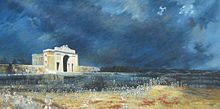James Buchanan, 1st Baron Woolavington
James Buchanan, 1st Baron Woolavington,
Early life
Buchanan was born in
Business career
Buchanan joined William Sloan & Co, a Glasgow shipping firm, as an office boy when he was fourteen or fifteen, and was later promoted to be a clerk. In 1868, he joined his brother William in his grain business, also in Glasgow. In November 1879, he moved to London as an agent for the Leith whisky blenders Charles Mackinlay & Co.
He realised that there was an untapped market in
In 1909, Buchanan proposed a merger between the "big three" whisky firms: Buchanan's,
Other interests
Buchanan was vice-president of the
Philanthropy


He spent much of his wealth on philanthropic projects. He bought the
Thoroughbred racing
For more than two decades, Woolavington was a significant owner/breeder in the sport of
Honours
Buchanan was created a
Family and personal life
On 5 December 1891, Buchanan married a young widow thirteen years his junior, Annie Eliza Bardolph (née Pounder). Annie already had a son and a daughter;[2] together the couple had a daughter, the Honourable Catherine Buchanan, and a son who died in infancy.[1] Annie was a nurse and worked in London hospitals during the First World War.
In 1903, Woolavington bought the manor of Graffham from the Wilberforce family, and built a village hall.[11]
Lady Woolavington died suddenly in October 1918.[2]
The peerage and baronetcy became extinct on Woolavington's death at Lavington Park in August 1935, aged 85. He left an estate worth over £7 million and was buried in the nearby churchyard of Graffham.[2] The manor of Graffham was bought by Euan Wallace MP.[11]
Footnotes
- ^ a b "Person Page". thepeerage.com.
- ^ doi:10.1093/ref:odnb/32151. (Subscription or UK public library membershiprequired.)
- ^ "Menin Gate at midnight | Australian War Memorial". www.awm.gov.au. Retrieved 26 February 2022.
- ^ "Woolavington, James (1st Baron) (1849–1935)". The National Horseracing Museum.
- ^ "No. 31830". The London Gazette. 19 March 1920. p. 3432.
- ^ "No. 31712". The London Gazette (Supplement). 30 December 1919. p. 2.
- ^ "No. 32598". The London Gazette. 3 February 1922. p. 954.
- ^ "No. 32563". The London Gazette (Supplement). 30 December 1921. p. 10709.
- ^ Fenton, Ben (22 May 2006). "Was this the richest (and most secretive) British tycoon ever?". The Daily Telegraph.
- ^ "No. 33675". The London Gazette (Supplement). 30 December 1930. p. 7.
- ^ a b "Graffham Pages 58-60 A History of the County of Sussex: Volume 4, the Rape of Chichester". British History Online. Retrieved 19 September 2022.
References
- James Buchanan & Co Ltd 1961 – Histories of Bristol Companies
- National Photographic Record (NPR): List of subjects commissioned - 1917-1958
